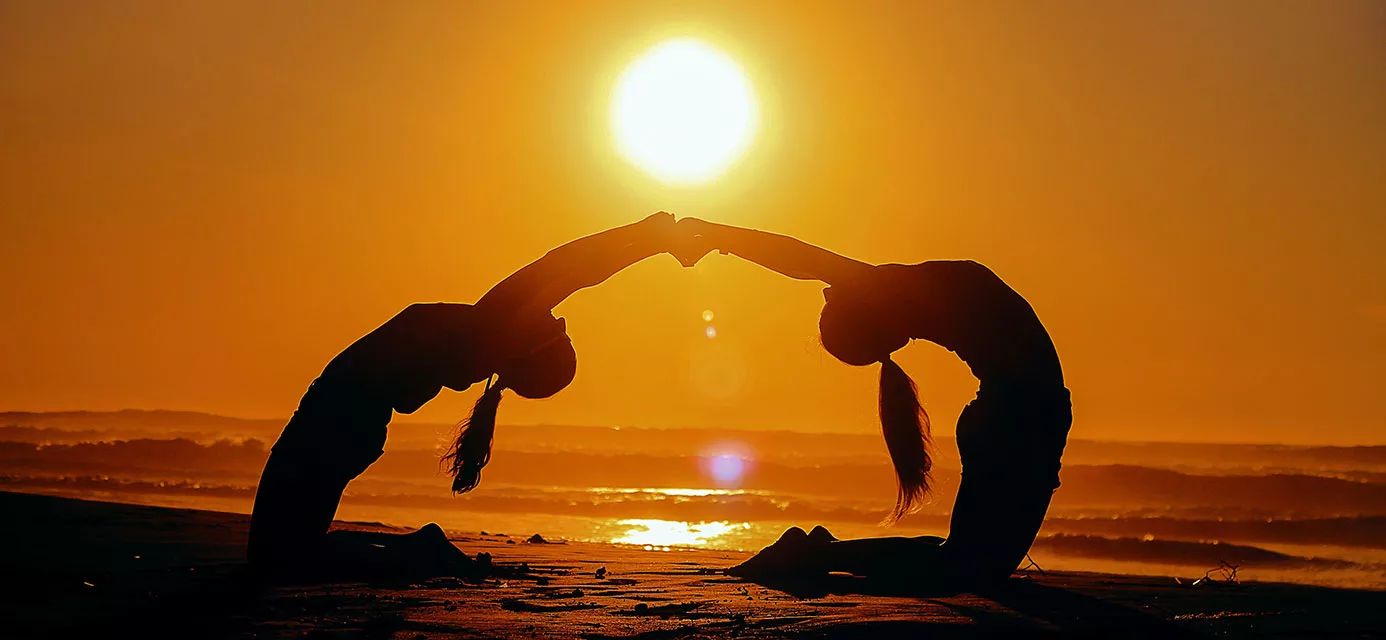Tommy Rosen has been practicing yoga since 1991. Moreover, that was also the year when he got sober for the final time. Therefore, Tommy believes that yoga has played an essential role in his recovery.
Tommy is a yoga teacher and addiction recovery expert. Furthermore, he has spent the last two decades immersed in yoga, recovery, and wellness. In fact, Tommy is one of the pioneers in the field of yoga and recovery. Additionally, he is the author of Recovery 2.0: Move Beyond Addiction and Upgrade Your Life and founder of the Recovery 2.0 online conference.
Tommy believes strongly that yoga is indispensable in the treatment of addiction. “Yoga and meditation are here to stay because [they] bring an astounding sense of well-being in the short term and have progressively positive effects in the long term,” he says.
According to Tommy, “Addiction is disconnection. Yoga is union. Addiction is characterized by a sense of lack. Yoga brings wholeness. Addiction is a ‘dis-ease.’ Yoga brings ease.”
Ancient, Evidence-Based Practices
The 5000-year-old practices of yoga and meditation exercises can be applied to contemporary substance abuse treatment. Furthermore, they can support recovery from a range of mental health conditions, such as depression, anxiety, and the after-effects of trauma.

Moreover, researchers have validated the impact of these practices for mental health and addiction.
In a nutshell, yoga and meditation are non-pharmaceutical, sustainable, evidence-based approaches that help teens get healthier. These practices help them heal physically, emotionally and spiritually. They do so by directly impacting teens’ still-developing brains, bodies, and nervous systems.
Yoga and Meditation Exercises for Stress & Anxiety
An increasing number of studies show that mindfulness meditation can help ease stress and anxiety. In fact, a review study at Johns Hopkins found that meditation was just as effective as antidepressants in treating symptoms of anxiety and depression.
How does it work? In part, mindfulness meditation encourages us to witness our emotions from a distance rather than getting caught up in them.
Furthermore, researchers believe that yoga’s combination of slow movement and conscious breathing calms the nervous system. Thus, yoga activates the relaxation response via the vagus nerve. This is the nerve that helps control the parasympathetic nervous system, also called the “rest and digest” system.

Moreover, yoga and mindfulness provide user-friendly tools for stress relief. Yogic breathing exercises can calm the nervous system very quickly. Yoga research studies show that teens effectively use these breathing exercises to relax before tests, to calm down when they’re angry and to help them sleep.
As a result, yoga can have a profound impact on a teenager’s daily life. It can also help prevent drug and alcohol abuse, since stress is a major factor for substance use. Without healthy outlets like yoga, teens too often turn to drugs and alcohol or other self-destructive behaviors to self-medicate the symptoms of stress.
Body-Based Healing for Trauma
Trauma is at the root of addiction, as well as other mental health conditions, says Tommy.
He defines trauma as, “any event that leaves undigested or unprocessed negative emotional energy stuck in the mind-body system. These stuck energies have to be processed out of the system or they fester.”
In other words, intense emotions and traumatic experiences get locked in the nervous system. Body-based interventions like yoga help relieve the imprints of trauma. They go beyond thoughts and reason to work on a subconscious level.
Clinical psychiatrist Bessel A. van der Kolk has done extensive research on how trauma affects the brain and body. He did a study with women with post-traumatic stress disorder (PTSD). These women were experiencing PTSD symptoms even after therapy. In the study, half the women attended a yoga class while the other half participated in a health education group.
After 10 weeks, those who had participated in the yoga program experienced a significant reduction in PTSD symptoms compared to the control group. In fact, more than half of them no longer met the criteria for PTSD, compared to 21 percent of the control group. Clearly, yoga has a significant effect on deep-rooted stress.

The Power of the Breath
There is an old yogic saying, Tommy notes: “If you can control the breath, you can control the mind.”
Tommy says, “The way that we breathe directly affects our emotional state and vice versa. When we feel anxious, worried, angry, or stressed, our breath becomes shallow. Shallow breathing sends a signal to our nervous system that our core need is not being met. This reinforces a sense of lack, which creates tension and stress.”
Tommy points out that many people do not breathe deeply. This negatively affects them on a mental level, as well as a physical level. Yoga improves posture and emphasizes deep breathing. As a result, it helps improve the way we stand, move, and breathe. This is particularly important for teenagers, because they spend so much time hunched over their phones and computers.
When we do yoga regularly, Tommy says, “we come to understand that by focusing on and controlling our breath, we can change how we think and feel. We can use the breath as a means of changing our emotional state and managing stress.”
From a scientific viewpoint, breath rate directly affects the vagus nerve. As mentioned earlier, the vagus nerve helps control the way the nervous system responds.
“By learning to do simple, long, deep breathing, which is accessible by almost anyone, we send a different message to our nervous system: that all is well and our core need is being met,” Tommy says. “This allows our body-mind system to relax and moves us toward healing, recovery, and wholeness.”
Yoga, Gratitude, and Mental Health
Scientists have found a clear link between gratitude and well-being. And yoga and meditation naturally increase feelings of gratitude.
The practice of yoga reminds us of our body’s strength and ability. In particular, people who have struggled with body image issues in the past feel a sense of “coming home” to their body. Thus, yoga practice creates feelings of gratitude and self-acceptance.
Moreover, mindfulness helps us become more aware of the present moment. As a result, we are reminded of the beauty around us. Additionally, we remember the preciousness of life.
Loving-kindness meditation is a practice involves sending well wishes to yourself and to others. Scientists have found that this practice increases positive emotions, including gratitude. Finally, the deep relaxation that occurs in Corpse pose at the end of a yoga class activates the nervous system’s relaxation response, which creates feelings of calm, inner peace, contentment, and gratitude.

Meditation for Teen Mental Health
Meditation shifts teens’ focus from analyzing their experience to simply observing it. Therefore, it keeps the mind and body grounded in the present moment. Concentration exercises like meditation decrease overthinking. That’s a good thing, because overthinking encourages depression and anxiety.
The ability to quiet the mind and stem the flow of wandering thoughts has multiple mental health benefits. Teens can start by learning how to meditate with a teacher. Then they can establish a habit of taking a few moments each day to practice this skill.
Benefits of Meditation
Meditation has been proven to have the following benefits:
- Reduces “wandering mind,” which is associated with unhappiness
- Increases empathy
- Helps with ADHD symptoms
- Encourages positive worldview
- Improves sleep
- Lowers anxiety
- Focuses concentration
- Enhances areas of the brain associated with well-being, self-regulation, and learning
- Decreases the volume of the amygdala, which is responsible for fear, anxiety, and stress.

Yoga for Depression
Yoga has been shown to increase stress resilience and feelings of connection. Therefore, it protects against depression. Researchers believe this effect is due to the stimulation of the vagus nerve, produced by the conscious movement and breathing practiced in yoga.
Low vagal tone is linked with depression and trouble recovering from stressful events. People with high vagal tone tend to recover more easily.
One study measured brain waves before and after a two-hour yoga class. Researchers found that alpha waves (associated with relaxation) and theta waves (associated with unconscious memory, dreams and emotions) increased by 40 percent. In other words, yoga relaxes the nervous system.
Furthermore, yoga increases brain chemicals that contribute to optimism and well-being, including endorphins, enkephalins, and serotonin.
In particular, the Kundalini Yoga practice known as Kirtan Kriya can also decrease symptoms of depression and improve mental health.

How Yoga & Meditation Heal Substance Abuse
Kundalini Yoga is known for its ability to support people in healing from addiction. Specifically, Kundalini Yoga includes practices designed specifically to break addictive habits and reduce stress. Consequently, the combination of breath work, mudra (hand gestures with specific meanings), mantra (chanting), postures, and meditation positively impacts the nervous system.
A Kundalini Yoga–based program called Superhealth was developed specifically to address addiction. The approach incorporates postures, meditation exercises, breathing applications, nutrition, counseling, and psychology.
Tommy Rosen is a Kundalini Yoga teacher. He says Kundalini Yoga helped him fully understand the connection between yoga and recovery.
According to Tommy, Kundalini Yoga “works to balance the endocrine system and nervous system while strengthening the physical body and calming the mind. The high that I feel from it is powerful but very different from a chemical high that leaves my system out of balance.”
Research has demonstrated the link between meditation and recovery from addiction. In one study, mindfulness practice was more effective in helping people stop smoking cigarettes than the American Lung Association’s “freedom from smoking” program.
Furthermore, a study with teenagers, funded by the National Institute on Drug Abuse, indicated that yoga practice decreases adolescents’ willingness to smoke cigarettes.

Protection Against Teen Risky Behaviors
Yoga builds self-regulation and executive brain functioning. As a result, it helps prevent teen risky behaviors.
The mindful practices of yoga and meditation develop the parts of the brain that regulate impulse control. Therefore, it affects how teens react to stress and challenging emotions and situations.
Mindfulness quiets down the limbic system, which is focused on impulses and primitive drives. Moreover, it buffers the prefrontal cortex, which is involved in making decisions and regulating emotions.
In addition, yoga fosters development of mind-body awareness. Consequently, teens develop a deeper awareness of their internal state. This translates off the mat into an ability to listen and respond to the body’s messages. Therefore, teens become more likely to make decisions that will benefit them. As a result, they are less inclined to engage in self-destructive behaviors.

In conclusion, yoga and meditation are powerful tools for positive change. Evidence-based research reveals they are as powerful as antidepressants. Moreover, these practices increase overall happiness and resilience. And they have no dangerous side effects.
“While I do not consider yoga to be a replacement for a program of recovery such as the 12 Steps, I have found it to be a critical part in a person’s overall approach to treating addiction,” says Tommy.
He adds, “The path of yoga is complementary to the path of recovery from addiction. In my experience, it decreases the likelihood of relapse and increases one’s enjoyment of life. And after all, the point is not to just survive addiction. The point is to thrive in recovery.”
Sources
Med Hypotheses. 2012 May;78(5):571-9.
JAMA Intern Med. 2014;174(3):357-368.
Front Hum Neurosci. 2014; 8: 770.
Drug Alcohol Depend. 2011 Dec 1;119(1-2):72-80.
Nucl Med Commun. 2009 Dec;30(12):956-61.
Int J Geriatr Psychiatry. 2013 Jan;28(1):57-65.
J Research Pers. 42(2) (2008) 854–871
Contemp Sch Psychol. 2015 Sep;19(3):184-192.
J Clin Psychiatry. 2014 Jun;75(6):e559-65.
Images Courtesy of Unsplash






